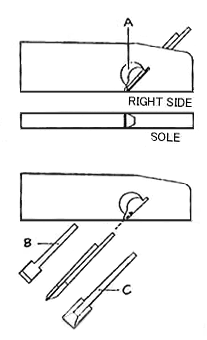| Also known as shakuriganna rηξ. A plane used exclusively for making grooves in a doorsill or lintel. If the width of the groove is 7 bu ͺ, or approximately 21mm, then the plane and cutting blade also measures 7 bu. The plane is narrow, but its elevation from the sole, daizura δΚ, is high enough to ensure that the cutting blade fits securely , and make the plane easier to hold. The wood shavings are ejected from a semi-circular opening in the side of the plane stock. Unlike the *anazukikanna Ληξ, which is also used to make grooves and has a special blade known as wakibari ej for planing the sides of the groove, the mizoganna has no wakibari. Thus, a side-shaving plane wakiganna eηξ, is used to shave the sides of the groove. |



